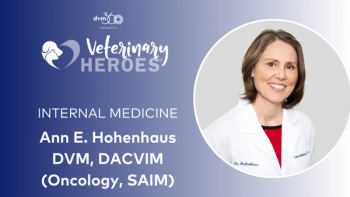
Get pet food savvy and bring the pet food conversation back to the veterinary clinic
Helping pet owners decipher the often confusing marketing and labeling of pet foods may prevent them from making well meaning, but uneducated nutritional choices in the store aisle.
Getty ImagesThe U.S. Food and Drug Administration (FDA) says on its website that there is a "wealth of information on pet food labels-if one knows how to read it.
Do you know the intricacies between meat and meat meal? Are you familiar with the "dinner" rule when it comes to pet food labeling? It's obvious pet owners aren't always familiar with the marketing and labeling associated with pet foods, but they are concerned about what they're feeding their dogs and cats. Ernie Ward, DVM, says the nutrition conversation is often happening in the aisles of big box stores-not the exam room.
Team members, not just veterinarians, are in a great position to initiate and engage in pet food conversations with clients. First, brush up on FDA labeling and pet food ingredient list lingo so you're better prepared to talk turkey with clients. Then, download client handouts to educate clients so they can make more informed nutritional choices for their pets once they've left the clinic. Maybe then, clients will feel less overwhelmed by the vast marketing of pet food brands and more likely to consult their veterinarian next time they have question regarding pet food.
Getty ImagesDecipher marketing claims
The name game. If an ingredient is used in the name of a pet food, at least 95 percent of the product must be the named ingredient-not counting the water added for processing and "condiments."
> Counting the added water, the named ingredient still must comprise 70 percent of the product.
> The named ingredient should be the first ingredient on the product's ingredient list, as lists must be declared in order of predominance by weight.
> If the name includes a combination of ingredients, such as "Chicken n' Liver Dog Food," the two ingredients must comprise 95 percent of the total weight.
> Also, the first ingredient listed in the name should be of higher predominance than the other.
> It is important to note that this rule only applies to ingredients of animal origin. Therefore, a product named "Lamb and Rice Dog Food," must still contain at least 95 percent lamb, according to the FDA.
Getty ImagesRing the dinner bell! When a pet food label reads "Beef dinner for dogs" or any fancy-sounding title that includes "dinner," "platter," "entrée," "nuggets" or "formula," the named ingredients must comprise at least 25 percent of the product (not counting the water for processing), but less that 95 percent.
> Counting added water, the named ingredients must comprise 10 percent of the product.
> A combination of named ingredients, such as "Chicken n' Fish Dinner Cat Food," must equal a combined 25 percent.
> The secondary ingredient must make up at least 3 percent of that total.
> Unlike the "95 percent" rule, the "dinner rule" applies to all ingredients, not just those of animal origin. The FDA says, for example a "Lamb and Rice Formula for Cats" means that while lamb is the predominant ingredient, 25 percent of the product is both lamb and rice.
When only one-quarter of the product may be, say, beef, it would most likely be the third of fourth ingredient on the ingredient list according to the FDA. "Because the primary ingredient is not always the named ingredient, and may in fact be an ingredient that the consumer does not wish to feed, the ingredient list should always be checked before purchase."
Getty ImagesWith cheese! The "with rule" is intended to apply only to minor ingredients manufacturers want to highlight on a pet food label.
> The "with" must occur outside the product name, such as "Beef Dinner for Dogs-with cheese."
> The highlighted ingredient must make up at least 3 percent of the product.
The FDA admits this rule can be confusing for consumers. A can of "Cat Food-with Tuna" means tuna may only be 3 percent of the product, whereas "Tuna Cat Food" must contain at least 95 percent tuna.
Packed with flavor. Under the "flavor rule" no specific percentage of the named flavor is required, but there must be enough for the ingredient to be detected in the product.
> The FDA says the corresponding ingredient may be beef, for example, but more often it is another substance such as beef meal or beef byproducts that give the characterizing flavor.
> "Digests," materials treated with heat, enzymes and/or acids to form concentrated natural flavors, are often used because only a small amount of chicken digest is needed to produce a "Chicken Flavored Cat Food," even though no actual chicken is added to the food.
> Stocks and broths are also used for flavoring, as is whey for milk flavor.
Getty ImagesSuper-ultra-premium. Label claims including the words "premium," "super-premium," even "ultra-premium" or "gourmet" are not required to contain any different or higher quality ingredients, says the FDA.
> These so-labeled products are not held to any higher nutritional standard.
> The same goes for the term "natural," although FDA says it can be construed to mean a lack of artificial flavors, colors or preservatives.
> And while some pet foods are labeled "organic," the FDA says there are no official rules governing the use of that label claim.
All your pet needs. Products that claim to be "complete," "balanced," or "100 percent nutritious," implies that the product is nutritionally adequate for the sole nourishment of a pet. However, to be recognized as such by AAFCO, products that meet the standards set forth by the association will include the words "… is formulated to meet the nutritional levels established by the AAFCO Food Nutrient Profiles" or "Animal feeding tests using AAFCO procedures substantiate … complete and balanced nutrition."
Getty ImagesIngredient list linguistics
Meat. Defined as the "clean flesh of slaughtered mammals and is limited to ... the striate muscle ... with or without the accompanying and overlying fat and the portions of the skin, sinew, nerve and blood vessels which normally accompany the flesh," according to the Association of American Feed Control Officials (AAFCO).
Meat byproducts. "The non-rendered, clean parts, other than meat, derived from slaughtered mammals. It includes, but is not limited to, lungs, spleen, kidneys, brain, livers, blood, bone, partially de-fatted low temperature fatty tissue, and stomachs and intestines freed of their contents. It does not include hair, horns, teeth and hoofs."
AAFCO says it is simply most of the parts of the animal other than the muscle tissue including familiar parts such as livers, kidneys and tripe, but also udders and lungs, which are not deemed "edible" by the U.S. Department of Agriculture for human consumption.
Poultry. "The clean combination of flesh and skin with or without accompanying bone, derived from the parts or whole carcasses of poultry or a combination thereof, exclusive of feathers, heads, feet and entrails."
In other words, "poultry" is the parts of the bird you would find if you purchased a whole chicken or turkey at the grocery store, AAFCO says. "Frankly, it often consists of the less profitable parts of the bird, such as backs and necks. Unlike "meat," it may include the bone, which when ground can serve as a good source of calcium."
Poultry byproducts. Byproduct "consists of non-rendered clean parts of carcasses of slaughtered poultry such as heads, feet, viscera, free from fecal content and foreign matter except in such trace amounts as might occur unavoidably in good factory practice."
AAFCO says it is similar to "meat byproducts," as it includes most of the parts of the bird that would not be part of a raw, dressed whole carcass such as the heart, gizzard and liver, but also other internal organs, heads and feet.
Getty Images"Meal." The following materials are all rendered products that according to AAFCO have been subject to cooking to destroy any harmful bacteria before they are shipped to a pet food manufacturing plant. Rendering removes most of the water and fat, leaving primarily protein and minerals. The term “meal” is used with these products as they are ground to form uniform sized particles. "The rendering process is designed to destroy disease-causing bacteria, leaving an ingredient high in protein that while unappetizing to people appeals to the carnivore's palate."
Meat Meal. "The rendered product from mammal tissues, exclusive of any added blood, hair, horn, hide trimmings, manure, stomach and rumen contents." Unlike "meat" and "meat by-products," AAFCO says this ingredient may be from mammals other than cattle, pigs, sheep or goats without further description. However, a manufacturer may designate a species if appropriate (such as "beef meal" if only from cattle).
Meat and Bone Meal. "The rendered product from mammal tissues, including bone, exclusive of any added blood, hair, hoof, horn, hide trimmings, manure, stomach and rumen contents except in such amounts as may occur unavoidably in good processing practices." AFFCO says it is similar to "meat meal," but can include added bone in addition to what is normally found in whole carcasses.
Animal Byproduct Meal. Identical to "Meat and Bone Meal," however it often includes byproducts in excess of what would normally be found in "meat meal" and "meat and bone meal," AAFCO says.
Poultry Byproduct Meal. "The ground, rendered clean parts of the carcasses of slaughtered poultry such as necks, feet, undeveloped eggs and intestines, exclusive of feathers except in such amounts as might occur unavoidably in good processing practices." AAFCO says it is essentially the same as "poultry byproducts," but in rendered form so most of the water and fat has been removed to make a concentrated protein/mineral ingredient.
Poultry Meal. "The dry rendered product from a combination of clean flesh and skin with or without accompanying bone, derived from the parts or whole carcasses of poultry or a combination thereof, exclusive of feathers, heads, feet and entrails."
Getty ImagesVitamins and minerals. AAFCO says there are many inorganic compounds used to supply minerals and most of them can be identified by what they supply with names beginning with elements such as calcium, cobalt, copper, ferric or ferrous (meaning Iron), magnesium, manganese, potassium, sodium, or zinc.
Some examples of ingredients used to provide vitamin activity include:
> Cholecalciferol (supplies vitamin D from animal sources)
> Ergocalciferol (supplies vitamin D from plant sources)
> Riboflavin supplement (a source of vitamin B2)
> Alpha-Tocopherol acetate (supplies vitamin E)
> Thiamine mononitrate (source of vitamin B1)
> Pyridoxine hydrochloride (source of vitamin B6)
Amino acids. Commonly used additives often have chemical sounding names such as: DL-Methionine, L-Lysine, L-Threonine, DL-Tryptophan, Taurine (particularly important to cats), DL-Arginine, L-Tyrosine.
Chemical preservatives. Commonly used ingredients include: ascorbic acid, benzoic acid, butylated hydroxyl anisol (BHA), butylated hydroxyltoluene (BHT), calcium ascorbate, Citric acid, ethoxyquin, potassium sorbate, sodium bisulfate, and mixed tocopherols. Some of these preservatives have limits to the amount that can be used or what types of products the preservative can be added to. The fact that a preservative has been added must be shown.
Conditioning agents, thickeners, emulsifiers, sequestrants, flavors and seasonings. Commonly used ingredients include: carrageenan, propylene glycol (in dog food only, propylene glycol is prohibited from use in cat food), sodium hexametaphosphate (to reduce dental tartar in dogs and cats), agar-agar and guar gum.
When in doubt, ask
The "manufactured by" label statement identifies the party responsible for the quality and safety of the product, according to the FDA. If the label reads, "distributed by," an outside manufacturer produced the food. However, the name on the label still designates the responsible party. The FDA encourages consumers with questions or complaints about products to use the information provided on the bag to contact the responsibly party.
Client handouts
When you discuss nutrition with clients, give them two handouts that will help them
Newsletter
From exam room tips to practice management insights, get trusted veterinary news delivered straight to your inbox—subscribe to dvm360.





